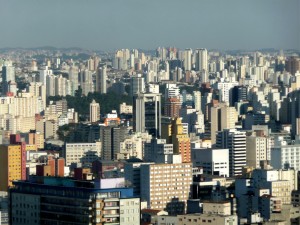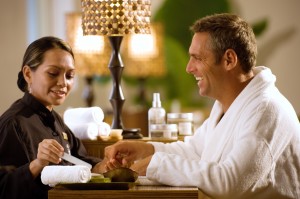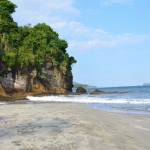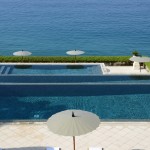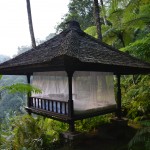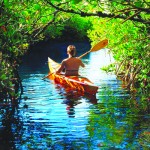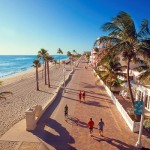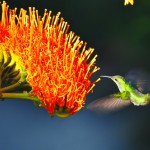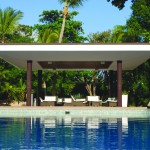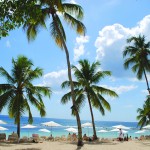By ROBERT ELIAS DEATON
Swaying palm trees, the sound of distant waves lapping upon pristine white or red or black sand beaches, tropical sunsets silhouetting hula dancers in flowing grass skirts. Yes, this is paradise, otherwise known as Hawaii.
Often referred to as the ultimate in vacation destinations, Hawaii is more diverse than any state in the union—and the only state comprised entirely of islands numbering in the hundreds. Of these, seven are inhabited, and each has a charm unique to its position in the island chain.
The most populated and gay famous is Oahu (The Gathering Place), the home of Waikiki beach, Honolulu, high-rise condos, and the only royal palace on U.S. soil. ’Iolani Palace, built in 1879 for King Kal?kaua, isn’t grand by international palace standards. It is, however, unique as the only example of Hawaiian Renaissance architecture. Located at 364 S King Street, the palace is in downtown Honolulu and is open to the public.
The Royal Hawaiian Hotel (2346 Kalakaua Ave) has a long history of celebrity guests, its pink façade welcoming heads-of-state, financiers, and movie stars. But despite repeated restorations, the hotel is no longer the Queen of Waikiki Beach, though a visit to the lobby is always a pleasant journey back in time. For the height of luxury accommodations, there is none finer than the Halekulani Hotel (2199 Kalia Road) which has been ranked among the top five-star hotels in the world since its opening in 1997. With Hawaii’s acceptance of civil unions in January of this year, the hotel has become the favored spot for beach-front ceremonies and receptions.
The gay beach in Hawaii is a few blocks away from Halekulani (toward Diamond Head volcano) on Queen’s Surf Beach near Kapiolani Park. Before you get too excited, the name derives from Hawaii’s last royal, Queen Liliuokalani. Her beach house and pier were once positioned at the exact spot where current day lesbians and homosexuals paddle board and sun. On weekends, the adjacent park area becomes Sunset on the Beach, with movies shown under the stars. Too much fun.
Right around the corner, you’ll also find Hula’s Bar and Lei Stand Waikiki (134 Kapahulu Ave), the Hawaiian version of Stonewall. It’s been a fixture on the Honolulu gay scene since Adam and Eve did their thing, or perhaps longer some say.
Our dear friend Jack Law (otherwise known as Da Kine or Big Daddy) is the owner of the joint, which is located on the second floor of the Waikiki Grand Hotel (a good inexpensive choice if you want to say close to the action). At dusk, the bar’s sliding glass windows glide open and transform this gem into a visual postcard of people watching, sunsets and passing catamarans. The drinks are strong, the music is upbeat, and the clientele a mixture of cute, rugged, muscled locals with a few paunchy tourists advertising themselves by their sunburn.
If you’re in a hiking mood, from Hula’s follow Kalakaua Ave. along the beach toward Diamond Head until it turns into Diamond Head Road. Four blocks ahead watch for the turn-off on your right to Beach Road. This takes you to Diamond Head Lighthouse, which was completed in 1917 and was listed on the National Register of Historic Places in 1980. It’s a great spot of soak up the sun. You might even meet some new friends, since this is a hot gay rendezvous point.
An extra bonus: on the way home, you’ll pass right by Hula’s again. It’s the perfect time to visit Jack, and tell him Guy Magazine says Howzit?

